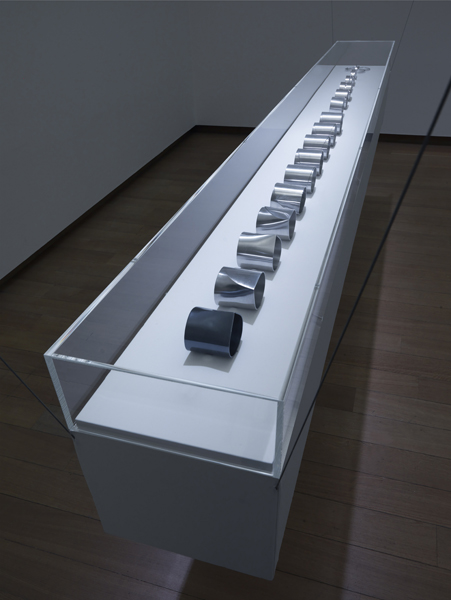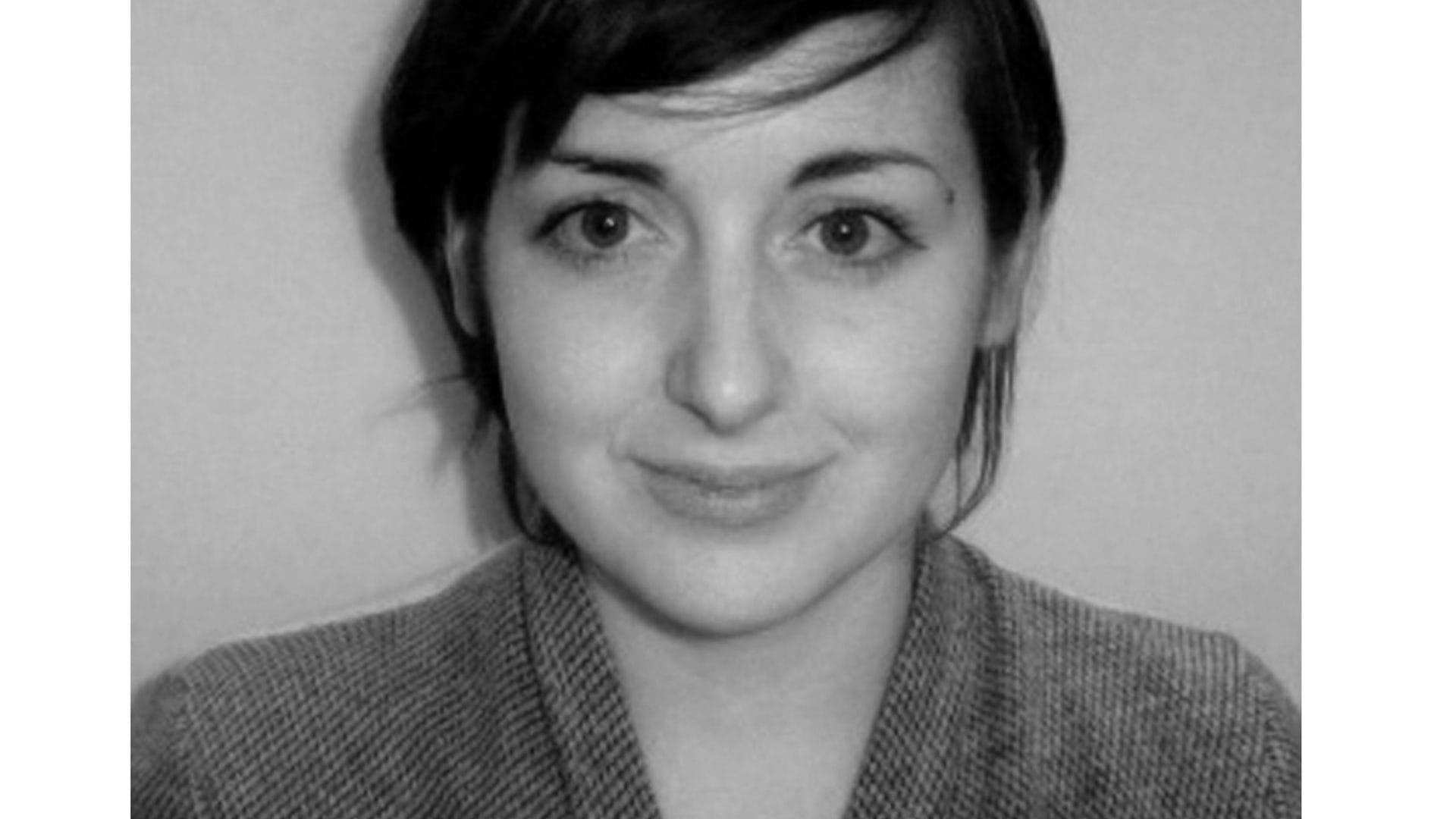The Gijs+Emmy Spectacle
February 22–August 24, 2014
Stedelijk Museum Amsterdam, Amsterdam, The Netherlands
Curated by Marjan Boot

Five years.
In 2012, after a shutdown, renovation, and enlargement that lasted eight years, the Stedelijk Museum reopened. The extension’s shiny white surface is made out of a new composite, a fibrous material that helps create a bright contrast with the pale stones and red bricks of the original Weissman building of 1895 and, incidentally, makes it look like a giant rectangular bathtub. Architectural debate notwithstanding, the newly formed compound is undeniably defined by its allegiance to both past and future, as is the work of Bakker and van Leersum exhibited inside the museum. There, we are invited to see a reconstruction of the experimental catwalk presentation that Gijs and Emmy created on the occasion of Edelsmeden 3 (an exhibition of young silversmiths), which propelled their careers, along with their line of fold-angle bracelets, bespoke jewelry, and the Clothing Suggestions they presented at the ballet Mutations, as well as other works made for various exhibitions.

Their common career started in 1966 when they exhibited together at Riekje Swart’s art gallery (1964–2000) in Amsterdam. Bakker and van Leersum presented gold, silver, and a few stainless steel pieces (Point Welded Bracelet, Spoon Bracelet, Ten-Loop Bracelet, and Tie Clip, among others) that implied inventive systems of geometrical construction and a serious commitment to the act of polishing. These works caught the attention of Liesbeth Crommelin and Wil Bertheux, respectively the curator and the head of Applied Arts and Design at the Stedelijk Museum at the time. When the duo got invited, along with three other silversmiths, to show their works at the prestigious museum, both artists fought to convince the curators to let them have a catwalk show (it was probably the first jewelry catwalk show ever, and it was certainly the first catwalk show at the Stedelijk). Worn, the jewelry would have more impact. Its proportions were thus conditioned by both the artistic ambition of the makers and their pragmatism: The jewelry clearly had to be larger to be noticeable while on stage. Aluminum met the requirements of these sizable pieces by being extremely light and giving a modern, industrial, and shiny look.

Intent on retracing the working relationship between the two, Boot approached Bakker with her proposal in 2011, and he was readily convinced by what he describes as her “remarkable scientific approach.”[2]
The project, however, would not be without challenges. Chief among them was to find an appropriate format in which to display the exhibition. Together with assistant-curator James Tergau, Marjan Boot wanted to revise it, to refresh it, and yet to draw a portrait of the time. Instead of directly restaging the catwalk show, they opted for a more complex configuration where vitrines, movies, and work shown on dummies all relate to each other. The aim is to gather the impressions and memories of colleagues, customers, and friends in a sort of “before/after” dialogue without compromising the youthfulness that radiates from the work itself.
The project, from conception to opening, took about three years to put together (the show just closed at the Stedelijk, but there are plans for it to travel to other venues in 2015 and 2016). Like other contemporary endeavors to restage historical shows, this one faced several problems: the dispersal of the original inventory and the lack of archive entries, in particular, and a changed sensibility in museology, in general. In this case, the biggest problem was the lack of documentation for the show Edelsmeden 3. Strangely enough, there was no film footage of the show, and only one photograph of the whole event, showing the model Sonja Bakker during a rehearsal, on her tiptoes, hand against the wall while looking sideways. (The near-absence of archive material contributed to the show’s subsequent cult status, as did the shocked reviews of it in newspapers and magazines.)

The curating team used a clear and readable method—showcases for objects, frames for archive material, suspended dummies for garments and larger ornaments—to which they added videos to both document and regenerate the peculiar atmosphere that originally surrounded the work.
The entry to the exhibition room is a dark and angular corridor that leads us to a big screen. On it is projected a film by Bart Hess, who also worked with Studio Harm Rensink to design the exhibition. The black and white video focuses on several women filmed from various angles; they move around smoothly, turn their heads and arms, enigmatically occupying an undefined, unfurnished gray space. The short-haired and eye-lined models in miniskirts wear the recognizable Stovepipe Necklace and other aluminum collars that reflect the spotlights’ glow. The soundtrack to the Bart Hess video—Fantasy in Orbit: Round the World with Electronic Music (Tom Dissevelt, 1963)—is the original music Gijs and Emmy used for the catwalk show. It dictated the movements of the models and was meant to enhance the futuristic atmosphere. Today it sounds loose, slow, and punctuated by high-pitched electronic sounds. The overall effect makes you feel like you are entering a dark, humid cave where you disconnect from the outside world.
[video: http://vimeo.com/89612291 width:500 height:281]
Walking around the screen, we access the main room. Here we see the outfits; they “levitate” on black dummies. The dresses and the jumpsuit are made out of Ottoman silk, nacreous turquoise, fuchsia, black, and white, and are given ample yet structured silhouettes. The cuts are similar to contemporaneous looks by Courrèges, Cardin, or Rabanne, who likewise incorporated new materials like PVC, Plexiglas, or aluminum in their collections to add playfulness.
The textile parts of the garments were originally made by Tiny Leeuwenkamp-Bakker, Gijs’s sister, but were lost or damaged and had to be reproduced for the show. Noticeably, all materials used under the signature of Gijs and Emmy have aged differently. I liked seeing the balance between organically aging textile or plastic creations that only needed to reflect their time, and other more ageless pieces in metal that will easily get to shine again years and years after their fabrication.
The range of works to see is large. There are the perfectly geometric bracelets made from industrial materials, like the Möbius created out of a twisted square aluminum rod. There are also the playful nylon costumes that were meant to add geometrical forms to the body in order to modify its appearance; these were first exhibited at gallery Art & Project in January 1970, and later used by choreographer Hans van Manen for the dance production Mutations (Nederlands Dans Theater, 1970). And let’s not forget the flesh-colored Jumpsuit with its fancy zippers on the crotch, or the modular plastic Head Form.
The lack of museological distinction between fashion and jewelry supports the artists’ point of view that these were twin extensions of themselves, and equally strong expressions of their individual ideals and wishes. Emmy especially stayed committed to clothing in her work: She was very concerned by how fashion could empower youth and women. It is somewhat disappointing, in this context, that the curator made no attempt to show their work directly worn by people (as on the original catwalk). This emphasis on contextualization (film, photography, newspaper articles, and other archival documents) over reenactment ultimately turns the objects into witnesses of their time and—one assumes—has to do with the curator’s desire to encourage a dialogue about our present concerns and expectations for the future.

Indeed, the show underlines the fact that current scenarios of empowerment (or change) have an ambivalent relationship with “things.” On one hand, our culture seems intent on dematerializing most of our cultural possessions, like photographs and music records. On the other, the popularity of 3-D printing, and the myths of production autonomy that go with it, suggests that the age of objects is not completely over (this version of empowerment has more to do with market forces and economic models than with gender parity).
The fields of art and design are mutating, and there will thus be new notions of value created, new codes to live within in the near future. Our concerns about, and views of, material goods have changed a lot since the sixties, and in this context, the duo’s way of always looking forward comes as a very refreshing breath of air. Gijs Bakker still gets enthusiastic about evolution. “It is the designers’ job to adapt to these meaningful changes and to find out where the new stakes are,” he says.[3]
It must be the reason why he has taken on so many roles in his career so far—a jewelry and industrial designer, co-founder of Droog Design, teacher, lecturer, co-founder of Chi ha paura… ?, creative director for Han Gallery in Taiwan.
In a word, there is a palpable energy, genuine and fearless, in the works that the two artists put together. We could easily think that this drive came from youth, but I rather tend to think that Gijs + Emmy followed this equation:
(Jewelry) c+r = Purpose
In which:
c = context
r = risk
[1] Marjan Boot and Lex Reitsma, De show van Gijs+Emmy: Gijs Bakker + Emmy van Leersum, Mode- en sieraadontwerpen 1967–1972, Book+Film/The Gijs+Emmy Spectacle: Gijs Bakker + Emmy van Leersum, Fashion and Jewellery Design 1967–1972, Book+Film (Rotterdam: nai010 Publishers, 2014).
[2] Gijs Bakker, in conversation with the author on June 16, 2014, at his workshop.
[3] Gijs Bakker, Ibid




